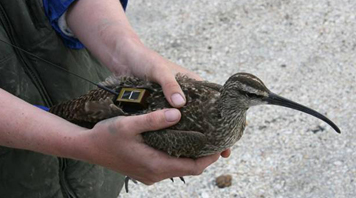Hope arrives early
Hope, a whimbrel carrying a satellite transmitter, has returned to her old spring haunts on the Eastern Shore of Virginia following an amazing year-long odyssey recorded by shorebird researchers.
Bryan Watts, director of the Center for Conservation Biology, said Hope is the first of the shorebirds to be tracked by satellite over the full circle of its annual migration, which extends from the tropics to the arctic in a looping path that covers more than 14,000 miles. Watts said the center staff is anxious to get to the Eastern Shore to obtain visual confirmation of Hope’s arrival.
“Hope has just gotten in and we’ve been wanting to get over there,” he said. “She’s probably over there with fairly few birds. Usually when the birds first come in, they’re less shy. They’re worn out so that you can get closer to them.”
Satellite tracking showed that the bird had been on St. Croix in the U.S. Virgin Islands since Aug. 14, where she has been observed foraging on Great Pond, a Birdlife International Important Bird Area. Hope left St. Croix on the evening of April 9, flew east of Puerto Rico and northwest out over the open ocean for nearly 1,500 miles. She came near land around Cape Lookout and then followed the shoreline around the Outer Banks of North Carolina and up to the lower Delmarva Peninsula, making landfall around 3:15 in the afternoon of April 11.
Hope covered approximately 1,660 miles in less than two days on her trip from St. Croix. She even has settled on the same marsh where she was captured in the spring of 2009. Watts said that Hope’s journey has confirmed how much the life cycle of whimbrels is dependent on specific staging sites, “layover” areas where birds can rest and feed before resuming their long migrations. Hope and other satellite-tracked whimbrels are revealing that the migrations of the species are surprisingly structured, he added.
Hope is one of several birds that have been fitted with state-of-the-art 9.5-gram satellite transmitters in a collaborative effort by the Center for Conservation Biology and the Virginia Chapter of The Nature Conservancy to discover migratory routes that connect breeding and winter areas and to identify en route migratory staging areas that are critical to the conservation of this declining species. Virginia’s Eastern Shore—and the Delmarva Peninsula in general—hold several such staging areas. Updated tracking maps for Hope and other whimbrels may be viewed online.
Hope was originally captured and fitted with a satellite transmitter on May 19, 2009 while stopping over on the Delmarva Peninsula of Virginia. She left Virginia on May 26 and flew to the western shore of James Bay in Canada. She staged on James Bay for three weeks before flying to the Mackenzie River near Alaska, and then on to the Beaufort Sea where she staged for more than two weeks before flying back to Hudson Bay. Hope then staged on South Hampton Island in upper Hudson Bay for three weeks before leaving on a non-stop flight of more than 3,500 miles over the open Atlantic to St. Croix where she has spent the winter months. In less than one year, this bird has travelled more than 14,170 miles, the CCB reports.
Watts said that Hope arrived on her spring staging marsh a bit earlier than expected. Most of the birds won’t be coming in for another two weeks. An early arrival probably means that Hope will leave early as well.
“Most of the birds have been leaving the third week of May. If Hope stays that long, we’d be pretty surprised,” he said. “It would be a pretty long staging period. That’s something we’re real interested to see. I’m guessing Hope will take off for the north probably about mid-May.”
Watts said the CCB will continue to track Hope as long as the transmitter holds out, although he says the unit is “on borrowed time.” The solar-powered tracking unit recharges continually, but he says the trackers rarely last a year.
The Center for Conservation Biology is a joint program of the College of William and Mary and Virginia Commonwealth University. Satellite tracking represents only one aspect of a broader, integrated investigation of whimbrel migration. During the past two years, the CCB, in partnership with The Nature Conservancy, has used conventional transmitters to examine stopover duration, conducted aerial surveys to estimate seasonal numbers, collected feather samples to locate summer and winter areas through stable-isotope analysis, and initiated a whimbrel watch program.
Continued research is planned to further link populations across staging, breeding and wintering areas and to determine the ecological requirements of whimbrels staging along the peninsula. Funding has been provided by The Nature Conservancy, the Center for Conservation Biology, The U.S. Fish and Wildlife Service, the Virginia Coastal Zone Management Program, The Toronto Ornithological Club, the Toronto and Region Conservation Authority and the Northern Neck Audubon Society.
















